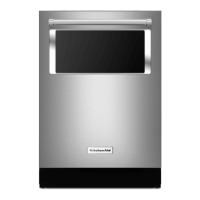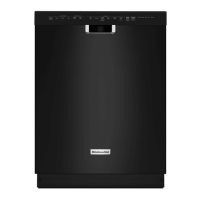6-14
n
KitchenAid 2015 Microltration Dishwashers
TESTING
For Service Technician Use Only
DANGER
Electrical Shock Hazard
Only authorized technicians should perform
diagnostic voltage measurements.
After performing voltage measurements,
disconnect power before servicing.
Failure to follow these instructions can result in
death or electrical shock.
Wash Motor
This test will check the wiring to the wash motor and the wash
motor itself. The following items are part of the wash motor
circuit.
n Harness/Connecon
n Wash Motor & Capacitor
n Control Board
Test Procedure
1. Check the tub and sump for anything that may be
impeding water ow. Inspect and if necessary clean the
coarse-lter system. Also, inspect spray arm water nozzles
and clean if needed.
2. Check the wash motor and electrical connecons by
performing the Service Diagnosc Cycle. The following
steps assume that this step was unsuccessful.
3. Unplug dishwasher or disconnect power.
4. Remove toe and access panels to access control board.
5. Unplug connector P5 from control board.
Strip Circuit – Wash Motor
6. Check the wash motor—using an ohmmeter, measure the
resistance between P5-1 and P5-2.
¾ If the resistance is between 10-15 ohms, the wash
motor and harness are good. Go to step 7.
¾ If outside the range, replace the wash motor.
¾ If an open circuit is detected, check connecons and
harness connuity between control and wash motor. If
good, replace the wash motor.
7. Reconnect P5 to control board.
8. Set voltmeter to AC and connect leads to test-pads
P5-1 & P5-2 on the control board. Plug in dishwasher or
reconnect power.
9. Start the Diagnosc Cycle and at the proper interval
measure for AC out of the control between P5-1 & P5-2.
(Refer to Wash Motor Strip Circuit below.)
¾ If no AC voltage is measured, replace the control board
and retest.
¾ If 120 VAC is measured and wash motor is running, go
to step 12.
¾ If 120 VAC is measured and wash motor is not running,
go to step 10.
10. Test the wash motor capacitor. NOTE: A faulty capacitor
may cause the motor to “hum,” not start, or start slowly.
a. Discharge the capacitor by touching the leads of a
20,000 Ω resistor to the two terminals.
b. Disconnect the wires from the capacitor terminals.
c. With an ohmmeter, measure across the terminals and
note reading.
¾ If a steady increase in resistance is noted, capacitor is
good. Replace wash motor assembly and retest.
¾ If the capacitor is either shorted or open, replace
capacitor. and retest.
11. If the preceding steps did not correct the wash motor
problem, replace the control board.
12. Unplug dishwasher or disconnect power.
13. Reassemble all parts and panels.
14. Plug in dishwasher or reconnect power and run Diagnosc
Cycle to verify repair.
4
Control Pinout
Meter Check of Loads and Fuses
Dishwasher Strip Circuits
The following individual circuits are for use in diagnoses. Do not continue with
the diagnosis of the appliance if a fuse is blown, a circuit breaker is tripped, or if
there is less than a 120-volt power supply at the wall outlet.
■ Unplug dishwasher or disconnect power.
■
Perform resistance checks. To check resistance of a component,
disconnect harness leads first.
Door Switch
Wash/Rinse
Water Heating/Heat Dry and Water Sensing with O.W.I. Sensor (Water/Air/Soil/Temperature)
Pump is washing. Control monitors temperature during water heating periods. See “Wash/Rinse” and “Water Sensing with O.W.I. Sensor (Water/Air/Soil/
Temperature)” circuits.
Fill
(Top)
W2
P5
P6
P7
P8 P9
P10 P11
P12
P13
-4
-3
-2
-1
-2
-1
-1
-6
-9
-1
-6
-1
-6
-1
-5
-6
-1
-3
-5
-1
-2
-4
-6
-1
-3
(OWI)
P12 (Wide Out)
P13
P4
P5
P6
BR
P7
BU
P8
RD
P9
V
P10
BR
P11
RD
P12
YL
Ω of F9 Triac Fuse
Electronic Control
Electronic Control
Micro PinMicro Pin
Micro PinMicro Pin
K4
Motor (N) Relay
K3
Heater (L1) Relay
K2
Pilot (L1) Relay
K1
Heater (N) Relay
N.O. N.O. N.O. N.O.
(To Wash Motor)
(To Heater)
(To Wash Motor,
Vent, and Triac Loads)
(To Heater)
N.O.
Door
Switch
Sensing
Input
Ref
P9-5
P10-4
Door
Switch
P9-6
13V
VV
Motor Power
BK
N.O.
TURQ
(LBU)
K2
Pilot L1 Relay
(Also see Door
Switch Circuit)
Electronic Control
P4-2
P5-2
Pin 3
Pin 2
K4
Motor N Relay
(Also see Door
Switch Circuit)
WH
P5-1
P4-1
Sense Resistor
or Jumper
0
Ω
N
L1
V
Y
Y
AUX
Winding
6
Ω
- 10
Ω
CAP
23.5 µF
Run
Winding
3
Ω
- 7
Ω
Motor and Capacitor
(Wash Pump)
120V, 60 Hz, 190W typical
TURQ
(LBU)
Electronic Control
N.O.
L1
BK
Electronic Control
N.O.
K3
Heater L1 Relay
(Also see Door
Switch Circuit)
Hi-Limit
Thermostat
Opens
207°F - 217°F
(97°C - 103°C)
Heater Element
8
Ω
- 30
Ω
120V, 60 Hz
785W Wet
500W Dry
N.C.
P4-2
P4-3
P4-4
P4-1
N
Electronic Control
N.O.
K1
Heater N Relay
(Also see Door
Switch Circuit)
Electronic
Control
P12-6
P12-5
P12-4
P12-3
P12-2
P12-1
Pin 1
Pin 2
Pin 3
Pin 4
Pin 5
Pin 6
Measure NTC resistance at P12-1 and
P12-3 connector disconnected from control.
Turbidity Drive
Foam Drive
OPT Sig
VCC
Ref
NTC
O.W.I. Sensor
Temperature: NTC Thermistor
46K
Ω
- 52K
Ω
at 77°F (25°C)
11K
Ω
- 13K
Ω
at 140°F (60°C)
Heater
BU/RD BU/RD
BU/WH
WH
YL
YL
YL
YL
YL
YL
L1
BK
P4-2 P6-4
P10-1
P6-6
P6-7
P6-9
P4-1
Use top hole of jumper
W2 as test point for F9.
N.O.
K2
Pilot L1 Relay
(Also see Door
Switch Circuit)
Fuse
F9
Electronic Control
Electronic Control
Float
(In normal position,
holds switch closed.)
BR
BR
N.O.
Pin 3 Pin 1
Overfill
Float Switch
No test pad on P6-4.
Recommend using test pad on P10-1.
No test pad on P6-7.
Recommend using test pad on P6-6.
Electronic Control
Float Switch
Input
BR
BR
Pin 3 Pin 1
Triac
Fill Valve
890
Ω
- 1,090
Ω
120V, 60 Hz, 6W
WH
N

